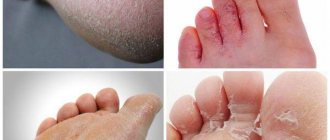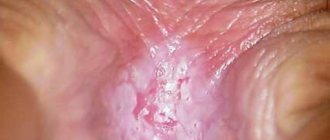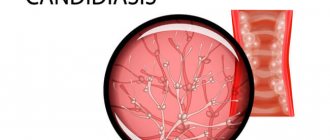Candidiasis is caused by Candida fungi, which are present in minimal quantities in the body under conditions of full immunity. Despite the fact that women are predominantly predisposed to infection with a pathogen, men often suffer from this disease.
First of all, the fungus affects the head of the penis and the foreskin (prepuce), if present. However, it is important not to confuse candidiasis (thrush), which is manifested by symptoms such as inflammation on the glans and rash, with inguinal ringworm (athlete's foot), which is expressed by itching around the genitals.
Types of fungus
Many types of these microorganisms are capable of causing mycoses.
But most often these are candida, dermatophytes and Pityrosporum Ovale.
Candida is a genus of yeast-like fungi.
They are part of the opportunistic human microflora.
They live mainly in the intestines, oral cavity, and on various areas of the skin, including the genital area.
Normally, the amount of this fungus is small.
Therefore, they do not cause inflammation.
However, against the background of reduced immunity or insufficient hygienic skin care, they can become a source of problems.
There are several dozen species of candida known that can provoke inflammatory diseases.
However, only 5-8 of them are common.
The rest are diagnosed only in isolated cases; most laboratories do not even conduct tests to identify these candida.
In 80% of cases, the causative agent is the fungus Candida albicans.
This is a favorable disease with a good prognosis.
As a rule, it does not cause complications, rarely recurs, and is easily cured with antifungal drugs.
It is worse if the fungus on the penis appears as a result of excessive growth of other candida, which are called atypical.
Dermatophytes are a group of fungi that belong to different genera and families.
But they have one thing in common: they can attack the skin.
They mainly infect those areas of the body where there is high humidity and temperature.
Main types of fungi:
- Trichophyton rubrum
- Trichophyton mentagrophytes
- Epidermophyton floccosum
With epidermophytosis, the fungus does not appear on the penis immediately.
In the vast majority of cases, the man's feet are primarily infected.
Fungal rashes appear on the legs when two conditions are met:
- sweating of the feet (often observed when wearing closed shoes, especially excessively warm ones)
- infection with a fungus from another person (for example, in a public swimming pool)
These fungi affect the skin between the fingers.
They are also able to penetrate the nails, causing onychomycosis.
Then the man brings the fungi into his groin with his own hands.
They settle here because the inguinal folds are warm and wet.
This area of the body sweats, which provides fungi with good conditions for existence and reproduction.
And only after this the spots can spread to the skin of the penis.
And this happens quite rarely.
Basically, the matter is limited to damage to the groin area.
Thus, with dermatophytosis, a characteristic feature is the presence of fungus in the groin and on the penis at the same time.
Another cause of this group of diseases is the lipophilic fungus Pityrosporum Ovale.
A man develops pityriasis versicolor on his penis.
This fungus is not dangerous.
It lives on the skin of all people.
But under the condition of increased secretion of sebum and sweat, it can multiply too intensively.
This leads to the appearance of spots on the skin of the penis.
Often a fungus appears on the penis and testicles at the same time.
It causes mild itching.
It can be quickly and easily cured with antifungal drugs and antiseptics.
But it recurs if measures are not taken to eliminate predisposing factors.
Where does fungus on the penis come from?
Different fungi appear for different reasons.
1. Candida.
Men get this fungal disease for two reasons:
- infection from a partner
- endogenous infection (development of fungi that normally live on the skin due to decreased immunity, diabetes, antibiotic therapy or other reasons)
Candida reacts even to minor disruptions in the immune system.
However, the inflammatory processes that develop in this case are not severe in most cases.
But the deeper the immunodeficiency, the more severe the infection.
Thus, HIV-infected people develop deep mycoses that threaten human life.
2. Dermatophytosis.
The fungus first appears on the feet and toenails.
Then it is carried into the groin area.
However, the development of a pathological process does not always occur.
This requires predisposing factors:
- tight pants and sweating
- obesity
- use of topical corticosteroids
3. Pityriasis versicolor.
This yeast fungus lives on the skin of all people without exception.
It is completely non-aggressive, does not cause strong inflammatory reactions and does not provoke significant skin damage.
Lives in the stratum corneum of the skin and hair follicles.
Pathological processes are provoked in the presence of predisposing factors:
- sweating
- increased sebum secretion (more common in young men)
- lubricating the skin of the penis with fat
- use of topical corticosteroids
This skin form of fungus on the penis is a chronic disease.
It often worsens in the summer.
Is penis fungus contagious?
Pityriasis versicolor is not contagious.
Candidiasis is conditionally contagious.
It is transmitted to a partner through sexual contact.
However, the inflammatory process does not always begin after infection.
Candida simply colonizes the vagina.
They are part of the opportunistic microflora.
For inflammation to occur, predisposing factors are needed.
Dermatophytosis is contagious.
If one family member is sick, others may also become infected.
The transmission of the fungus is caused not only by direct skin contact, but also by the sharing of hygiene products, shoes, manicure tools, etc.
What does fungus on the penis look like?
Which symptoms of fungus on the penis will be dominant depends on what type of microorganism has infected the skin.
Let's look at the signs of the most common mycoses.
1. Candidiasis.
This fungus most often appears on the head of the penis.
Although in some men it spreads further.
The urethra and inguinal folds may be involved.
In rare cases, deep candidiasis develops, which is characteristic of severe immunodeficiency.
Most often, candida fungus on the penis occurs in a mild form.
Main symptoms:
- white plaque on the head
- sour smell
- red spots
- papules
- severe itching
Sometimes the disease develops if a person does not receive timely treatment.
Then the plaque turns gray.
If at the beginning of the disease it is easily removed, now it is tightly fused to the tissues.
Attempts to remove plaque are accompanied by painful sensations.
Erosion opens underneath and can bleed.
A long course of candidiasis of the penis can result in painful cracks and erosive and ulcerative elements.
When the urethra is involved in the process, white discharge from the canal, burning and pain when urinating appear.
2. Dermatophytosis.
In most cases, the only symptom is plaque.
Upon examination, they are found on the feet, groin and penis.
They have clear boundaries.
Often follow the contours of the inguinal folds.
The plaques are red.
There is peeling of the skin of the penis due to fungus.
It starts from the center and spreads to the periphery.
Along the edges of the plaques, papular and pustular elements may be present.
After treatment, pigmentation remains.
The reason for a patient's visit to a doctor most often are spots; less often, patients complain of itching of the penis due to fungus.
3. Pityriasis versicolor.
In the vast majority of cases, there are no subjective sensations.
A person comes only about the appearance of spots.
They are formed, as a rule, not only on the penis.
Usually found simultaneously on the torso.
The spots have clear boundaries.
In dark-skinned people, they are usually hypopigmented (lighter than the skin).
In patients with fair skin - pink or red.
There is no peeling, but it can be caused by rubbing the stain.
Elements of the rash may persist even after treatment.
The spots do not disappear for some time even after the fungus is destroyed.
But at the same time the peeling disappears.
A complicated course of pityriasis versicolor is possible.
It can cause folliculitis and seborrheic dermatitis.
As a rule, the spots have a regular round shape.
They can increase in size and merge with each other.
Symptoms of fungus
Many people consider this infection with mild symptoms to be completely harmless, but this is a misconception. As the fungus progresses, it easily affects the mucous membranes of the head of the penis, which is diagnosed by doctors as candidal balanitis.
To timely diagnose candidiasis in men and prevent the development of complications, you need to know the symptoms of the disease:
- itching sensation in the area of the head of the penis;
- white spots and redness of the penis;
- irritation and swelling of the genital organ;
- discharge in the form of curdled flakes with an unpleasant odor;
- difficulty retracting the foreskin;
- painful urination and discomfort in intimacy.
In addition to the listed manifestations, problems with erection and timely ejaculation are possible - premature ejaculation, as well as its delay.
What tests are taken for fungus on the penis?
Often the diagnosis can be made clinically.
Although the rash with some fungal infections may resemble that of other diseases.
Therefore, confirmation of the diagnosis by laboratory methods is required.
The doctor examines the elements of the rash under a Wood's lamp.
This diagnosis makes it possible to distinguish mycoses from pseudomycoses (similar in their manifestations to diseases caused by bacteria).
Differential diagnosis of dermatophytosis is carried out with erythrasma.
When examined under a Wood's lamp, the doctor sees a green glow.
In the case of a bacterial infection, it would be coral red.
The diagnosis is made after taking a skin scraping and performing a microscopy.
Fungal hyphae are visible under a microscope.
Candidiasis is confirmed in the same way.
The doctor takes a swab-imprint from the penis.
It is stained with potassium hydroxide.
Microscopy visualizes filaments of pseudomycelium and budding cells.
Additional studies help determine the type of fungus and assess its sensitivity to antifungals.
They are indicated for unsuccessful treatment or frequent relapses, as well as severe candidiasis.
In this case, PCR or fungal culture is performed.
Pityriasis versicolor is detected by microscopic examination.
The doctor scrapes a spot on his penis.
He transfers the scales to a glass slide, stains them with potassium hydroxide and examines them under a microscope.
The preparation shows filaments of pseudomycelium and round yeast cells.
When examined under a Wood's lamp:
- greenish-blue glow if fungi persist
- there is no glow if a person has washed (luminophores are water-soluble, so they are washed off), and also if he is cured of a fungus (pityriasis versicolor is no longer present, but spots on the penis remain)
Diagnostic methods
To verify the causative agent of the disease, you will need to undergo tests
In order to identify a fungus on the head of the penis, you will need to take several tests and seek help from a urologist, mycologist or dermatologist. After the specialist conducts an examination to confirm the diagnosis, he will need to study the results of the smear. If the result is positive, then there is a need for a culture test to determine the type of fungus and its concentration.
It is worth understanding that there is more than one type of fungus that can affect the glans penis, so before prescribing treatment, the doctor must verify the type of causative agent of the disease.
Treatment of fungus on the penis
The main goal of therapy is to destroy fungi.
For this purpose, external or systemic antifungal drugs are used.
1. Candidiasis.
It is treated using local remedies if it is mild (most clinical cases).
A cream containing miconazole or clotrimazole is prescribed.
Systemic therapy is used less frequently.
Apply:
- fluconazole tablets
- Diflucan droppers
- itraconazole
2. Dermatophytosis.
It is advisable to find out the type of fungus, after which the doctor decides how to treat the fungus on the penis.
Basically, only local remedies are used.
Indications for prescribing systemic antifungal therapy are as follows:
- recurrence of fungus on the penis after it has been cured (relapse)
- ineffectiveness of a course of therapy with external drugs
- folliculitis (damage to the hair follicles of the skin of the penis and groin area)
- concomitant onychomycosis (nail fungus)
For the treatment of dermatophytosis of the penis, itraconazole is prescribed at a dose of 200 mg per day for a course of 1 week.
Use terbinafine 250 mg, once a day, for a course of 14 days.
Preparations for topical use:
- ketoconazole
- ciclopirox
- amorolfine
- naftifine and others, depending on the expected and identified type of fungus
3. Pityriasis versicolor.
The disease is treated with local remedies.
Hygiene products containing selenium sulfide are prescribed.
50% aqueous propylene glycol can be used 2 times a day for a course of 2 weeks or creams with imidazoles (ketoconazole, miconazole and others).
Rarely, general treatment is required.
It is necessary when:
- extensive affected area
- immunodeficiency
- failure of local therapy
- folliculitis
- seborrheic dermatitis
Tablets for fungus on the penis are prescribed internally - ketoconazole or itraconazole 200 mg per day, for a course of 1-2 weeks.
Why is bending an intimate organ dangerous?
If Candida fungus on the penis is not treated for a long time, this can lead to dangerous complications. The inflammatory process is concentrated around the head and foreskin of the reproductive organ and over time can spread to healthy organs of the genitourinary system, which will not only worsen the general condition of the patient, but also the entire clinical picture of the disease. If you don’t know how to treat fungus on the penis, seek help from a specialist before the prostate gland becomes inflamed due to this disease, which can lead to decreased potency, erectile dysfunction and infertility.
Causes of recurrence of fungus on the penis
If the fungus reappears, the cause may be either re-infection or relapse.
Let's consider the main reasons for this phenomenon for various infections.
1. Candidiasis.
Risk factors for relapse of candidiasis after its cure are as follows:
- fungal inflammation caused by atypical candida (not albicans)
- immunodeficiency conditions, including HIV
- severe prolonged illness, bed rest
- presence of candidiasis in a partner
- diabetes
The recurrent course of candidiasis requires a change in the approach to treatment.
Fluconazole may be prescribed for a course of six months, 1 tablet 150 mg per week.
When infected with atypical candida, a culture is performed to determine sensitivity to antimycotics.
Based on the results of this study, treatment is prescribed.
It is important to eliminate predisposing factors (normalize immunity, carbohydrate metabolism).
If possible, it is worth treating your partner if she also suffers from candidiasis.
2. Dermatophytosis.
The main reason for relapse is the persistence of fungus on the feet or nails.
This is possible if:
- During the examination, the doctor did not ask the patient to take off his shoes and did not examine his legs, and accordingly did not prescribe treatment
- therapy was carried out only with local medications and only in the groin and penis, but not on the legs
- nails are affected and the patient has not completed the course of treatment
With untreated foot or nail fungus, the risk of recurrence of dermatophytosis of the groin and penis is about 25%.
Most often, the cause is the persistence of foci of fungal infection on the nails.
This infection takes a very long time to cure, from 3 to 6 months.
During this entire time, the patient must take medications.
Not everyone has the patience and motivation to undergo treatment for so long.
The result is relapses of onychomycosis.
Then the fungus can be carried into the groin area and spread to the skin of the penis.
3. Pityriasis versicolor.
The causes of relapses are the same as the causes of the primary episode of fungal inflammation of the penis.
These include increased sweating and sebum production.
Sweating is the result of:
- hot clothes that do not allow air to pass through
- physical labor or sports
- some diseases (thyrotoxicosis, fever)
Increased sebum production is typical for young men with high levels of testosterone in the blood.
To prevent relapse, it is important to ensure:
- ventilation in the groin (loose clothing)
- adequate hygiene (removal of excess sweat and sebum)
In case of frequent relapses, the skin of the penis and other areas of the body where there are foci of pityriasis versicolor are treated with propylene glycol 1-2 times a month.
Symptoms and signs of fungal infection
A patient who has an excessive amount of Candida fungus on the glans penis experiences many discomfort symptoms. At the initial stage of development of thrush, almost all patients complain of increased dryness of the mucous membranes and tightness of the foreskin, which leads to pain when touched. The following symptoms clearly indicate that you need to visit a doctor:
- the development of an inflammatory process around the head and foreskin, which provokes active redness in these places,
- there is mucous discharge, sometimes of a cheesy nature,
- mild itching that constantly bothers the patient and if the disease is not treated, this symptom intensifies,
- burning sensation and unpleasant pain during urination.
Read also: Thermikon for nail fungus: release forms, instructions for use
If a man has at least two symptoms from this list, it is already necessary to make an appointment with a doctor.
The fungus also provokes the development of a disease such as Candida balanoposthitis. It is transmitted sexually, therefore, when the first signs of the disease appear, it is recommended to abstain from sexual contact for the duration of treatment. Treatment must be carried out simultaneously with a sexual partner. If you ignore the problem and do not start treatment immediately, you can provoke the occurrence of serious complications, such as persistent phimosis or erysipelas of the penis.
Another common disease that develops as a result of the active proliferation of a fungal infection. At risk are men whose work involves constant exposure to conditions of high humidity and high temperature. The symptoms of all these diseases are similar. Burning, itching, redness are the main symptoms of fungal development in the groin area.
In an advanced state, thrush in a man can provoke more pronounced symptoms. These include: elevated body temperature, pronounced chills, nagging pain in the lower abdomen and lumbar region, frequent urination, pain during sexual intercourse.
Prevention of fungal infection
It is unlikely that you will be able to protect yourself from fungi 100%.
But to reduce the risk of infection .
1. Candidiasis.
It can develop in any person.
There is no primary prevention as such.
reduce the risk if:
- use condoms
- lead a healthy lifestyle and maintain a good immune system
- ensure adequate hygiene of the genital area
- seek compensation for existing chronic diseases (for example, diabetes)
- do not take antibiotics without a doctor's prescription
2. Dermatophytosis.
When visiting public places where people walk without shoes, you need to thoroughly wash your feet before going home, preferably with detergents.
For example, after swimming in the pool you need to take a shower.
You should not use the slippers that are given to you in the pool or sauna.
It is better to bring your own shoes.
In this case, you will know for sure that it is not affected by the fungus.
Prevention is also necessary at home if one of the family members is sick.
It is worth using slippers.
In addition, the patient must be treated.
It is usually not contagious while receiving antifungal therapy.
To prevent fungus from getting into the groin and onto the skin of the penis, you need to get rid of tinea pedis and onychomycosis in a timely manner.
To do this, you should consult a doctor and receive appropriate drug therapy.
You need to be treated until the end.
Including in cases where drugs have to be taken for several months.
3. Pityriasis versicolor.
This disease is not contagious.
For prevention, you should ensure dry skin.
Adequate hygiene and avoidance of excessive sweating are necessary.
There is also drug prevention.
It is usually prescribed to those who have already had pityriasis versicolor.
You can choose one of the following options:
- using soap with salicylic acid or sulfur;
- soap with zinc pyrithione;
- use once a month 50% aqueous solution of propylene glycol.
Prevention with antifungal agents can only be carried out during the hot season.
Whereas in winter, pityriasis versicolor on the penis is rare (provided that clothing appropriate to the weather is worn).










